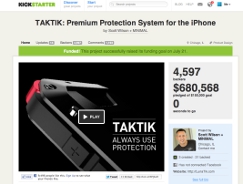Everyone’s favourite crowd funder, KickStarter, banned product renderings in an update to its Terms of Service. Al Dean wonders if this is a change that will truly benefit investors or does it show naivety on its part?
Crowd funding has become something of a phenomenon in the last few years, with some truly breathtaking examples of someone with a good idea bringing a product to market — but without the traditional business behind it.
What KickStarter and it’s brethren have done is turn this on its head. By allowing the inventor or the developer to pitch their idea, gather funding from a much wider portion of the populous, it has enabled them to succeed with an idea.
Some see it as the future of business whilst others deem it to be a first world issue of people wanting what’s new and cool before everyone else. There are also some who see it as purely a storefront for pimping the latest iPhone accessory or paying for tooling with customer’s money.
Highs vs lows
There’s been all sorts of success stories. Millions taken in pre-orders and businesses built in a matter of months.
Scott Wilson’s Lunatik) took advantage of the last generation iPod nano’s small form factor, combined it with some slick product design and delivered a watch strap product range that sold out in a month.
He wanted a couple of grand to fund the tooling, but ended up with just under $1,000,000 in 30 days.
Tanya talked to the team at RiftLabs about their iPhone compatible intelligent lighting system for amateur mobile photographers a couple of issues back.
The instances of success are as numerous as the disaster stories of investors taking a punt and getting not only long delayed products that seemingly never ship but also those that don’t ship at all.
Our place, our rules
On the 20th of September, the KickStarter team put out a blog post called “KickStarter Is Not a Store”. The company was pushing back against how the site was being perceived.
The problem is that KickStarter began as a way for people with an idea, be it a new product, service or artwork, to gain backing from the general public. What it has become in the intervening time, is a place for companies to develop an idea then take pre-orders, pay for tooling with customer’s cash and check out.
There’s nothing wrong with that at all, but it’s not what the site is about. Part of the team’s changes is to institute new policies for New Hardware and Product Design Project Guidelines. Specifically, “Product renderings are prohibited. Product images must be photos of the prototype as it currently exists.”
Of course, this caused a lot of confusion, so the follow up clarification was posted a little while after. “To clarify, we mean photorealistic renderings of a product concept.
Technical drawings, CAD designs, sketches, and other parts of the design process will continue to be allowed. Seeing the guts of the creative process is important. We love that stuff .
However, renderings that could be mistaken for finished products are prohibited.”
Their place, daft rules
Something struck me as a little bit off with this whole state of affairs.
Rendering is a key part of the development process for many of us — and a greater proportion than ever before — in all sorts of industries. Why ban it from a site that fosters new product development?
KickStarter appear to be saying that you can show off an early stage prototype, something that’s barely working.
KickStarter are making a mistake. Renderings are here to stay
You can also show off CAD drawings, sketches, schematics, but just no renderings. Someone even asked how they would tell. The answer came back: “We may not know.”
We do only a quick review to make sure a project meets our guidelines. If an obvious simulation or photorealistic rendering is spotted during that review, that project will not be allowed to launch.
If a simulation or photorealistic rendering is discovered after a project launches, that project will be canceled.
Everyone should continue to use their best judgment when deciding whether or not to back a project.” Well, that’s quite a response eh?
A case of the giggles
There’s something about people not really thinking through their actions, particularly when they take the moral high ground, which I find immensely amusing.
KickStarter are making a mistake. Renderings are here to stay, they’re created every day, in every country, in thousands of design offices. IKEA has announced that it’s moving away from physical photography for its catalogues to digital renderings in the next four years.
There’s also the simple fact that rendering tools now allow you to create stunningly realistic images. Take a look at Scott Wilson’s team’s renderings for their products. These look realistic, they convey what the product does and they show how it operates.
But they’re not the ultimate in photorealism. They’re close enough to look real, but very few would think they’re actual photographs.
Then there are those renderings that you simply can’t tell if they’re rendered or not. They’re so close to reality. Much of that comes down to small details and tricks that don’t have that “tell”.
On the other hand, I’ve also seen photographs that look like renders. It seems a little off to ban renderings on one of the most interesting product development platforms of the moment.
It shows that there’s a lot of misconception around the process, but ultimately, it means one thing — the renders are going to either get better so you don’t notice, or worse, so people think they’re a drawing. 
New rules say “no renderings”
Default







